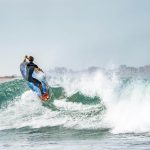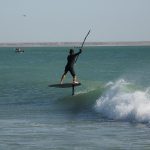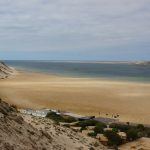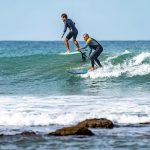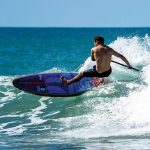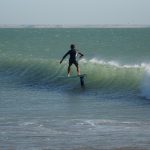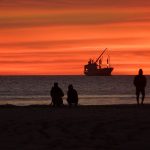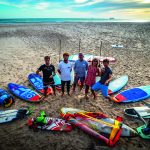MOROCCO
Six years after our last trip to Dakhla, we returned for two weeks during January and February. When you go back to a place full of good memories after a few years you’re always asking yourself about how it may have changed. Even more so in developing areas such as the Western Sahara. Let’s dive in to the Dakhla of 2019 compared to the place we enjoyed nearly 2000 days ago.
Words & Photos The Carpentiers
When we travel, our main goal is to enjoy the journey. At the end of it we ask ourselves one question: do we want to come back? If the answer is yes… well the trip must have been a success.
The Team
Like in 2013, 5 of the 6 Carpentiers were able to make the trip : Christelle and Gilbert, plus Ben, Pierre and Mat. The main difference this year was that we were able to fly straight to Dakhla from France. This was obviously faster, and turned out to be cheaper too as we took off from Paris. In 2013 we had to drive from Agadir to Dakhla (1500km!) because it was too expensive to book two different flights : Paris-Marrakech-Dakhla.
Other benefits? We got to enjoy a bird view of Dakhla peninsula and less than 6 hours after take off we were in the water surfing! In 2013 we had to drive two days from Agadir to reach Dakhla… and of course two more days to come back north at the end of our trip.
Diversify Your Quiver
It’s fair to say that over the years we don’t pack any lighter for surf trips. Dakhla is such an amazing place for watersports and not only do you want surfing gear but also sailing toys. SUP, longboard, shortboard, windsurfers rounded out the kit list for 2013. Divided into four boardbags we had ten boards for five people. This year we brought thirteen boards comprising three SUP surf, one longboard SUP, three longboards, two shortboards, one windsurfer, and one surf foil, sup foil and kiteboard and four sails. There were no yellow boards this time (Ben used to be sponsored by Naish) instead Starboard blue was dominant. Reflecting on what SUP boards we had six years ago, the biggest changes might be the shape and the weight. Board width is less, rails are thinner. Everything – paddles and boards – is also lighter.
What about size? Of course, it has dropped but in 2013 shorter SUP boards were already in our quivers (t that time Ben was riding a 7’4 for example). The most important addition to our quiver was the longboard SUP and the foils – they got quite a lot of use.
During our stay we had waves every day from knee high to overhead. Staying in Lassarga we knew that we would likely have some smaller days. During the down days we knew we’d want to keep enjoying the spots and our way to achieve this was simple: bring the right toys to stay stoked. And we had a blast, cruising at top speed with the foil, longboarding down the point, kitesurfing or SUP surfing: in 14 days no one was bored.
Weather, waves and crowd
It will not surprise anyone that in 2013 Dakhla was surrounded by sand and dust from the great Sahara Desert, and it still is in 2019. Dakhla’s value to tourists is in its warm water, wonderful lagoon, nice weather and great waves. If you don’t practice watersports or don’t worship the sun, going to Dakhla is kind of a nonsense because you won’t find anything interesting to do.
Going back there in early 2019 one of our big questions was the crowd: will the place be crawling with surfers?
In 2013 tourism was still quite restricted, it was slow or expensive to get there and accommodation was limited. Most of the tourists were Europeans with their own vans or trucks. They would come for wintert to enjoy the weather and tranquility of the place. A few other surfers, like us, were taking shorter trips in rustic hostels and camp sites. Most of the spots where uncrowded and we surfed plenty of times by ourselves or with only a few people. It was the same in the lagoon, just a few kitesurfers spread out.
In 2019 it seemed clear that Dakhla had entered another dimension.
In 2019, it seems the vast majority of visitors are flying in from Europe for short trips of one or two weeks. They want to rest under the sun, eat well and practice watersports with kitesurfing clearly the main attraction. In the lagoon it can quickly get overcrowded especially during the kitesurfing season which starts in March and lasts until October/November.
Surfers are not so numerous but for sure there has been an increase in the population especially on the days with low wind when the kitesurfers head ocean-side. More and more wave seekers are drifting down to Dakhla after discovering that breaks in the north of the country around Taghazoute and Imessouane for example, are often unpleasantly crowded.
Since 2013 the city has grown. Moroccans are encouraged to settle there by the national government and the local authorities clearly wish to make Dakhla a tourist-friendly city. These are two reasons that explain the growth that seems to keep going on (55 000 inhabitants in 2004; 106 000 in 2014; 117 000 in 2017). In fact, many buildings were still under construction during our stay. Entire neighbourhoods were ready to rise up from the ground as roads and street lights were already in place. In six years, plenty of hostels and resorts have been built on the land surrounding the Lagoon or along the coast. They are clearly here because of the flow of tourists. Just one example: in 2013, on the Foum Labouir spot, we stayed in a small camp with four “chalets”. Six years later, a big resort has been built right on the point with at least 20 times the number of beds available.
It’s fair to say that in just over five years Dakhla has become – or is at least becoming – mainstream. It is not roots anymore…but once you know and accept that it’s hard not to enjoy your time there.
Even if the city has evolved it still seems like frozen in time by some aspects. So you’ll find more and better hostels, you’ll meet more Europeans, the always delicious foods seem like a mix of cultures where Europe influence is gaining ground. But no doubt, the Dakhla of 2019 lets you know you are in Morocco. And probably more so than the city we discovered in 2011 and 2013. It’s sad to observe, but the Moroccan authorities project of acculturation of the Western Sahara is on its way.
If you have been in King Mohammed V country, especially at the surfing hotspot along the coast, you know what Moroccan hospitality means. You’ll find the same in Dakhla, people are kind, helpful and great vibes eminate from the locals you meet. In fact they are not really locals. Most of those who work in the tourism resorts are Moroccan. They came here to find new opportunities and in general a job. Each of them brought a bit of his culture to Dakhla and that’s why you’ll find a great diversity there. Few are really home and so everyone seems to act with you as if you were a member of his own family.
During our two weeks there we had good surf, enjoyed mostly uncrowded waves, share great vibes, appreciate amazing food, made new friendships and lived in unreal accommodation. Do you remember our question? Guess our answer… SUP International



